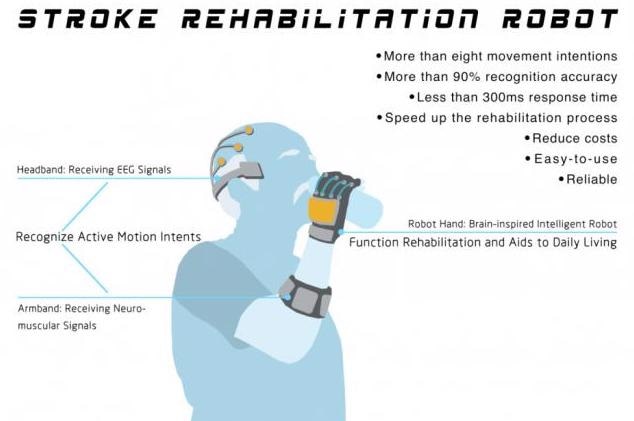Strokes happen when there is an interruption or reduction of blood supply to a part of the brain. It is considered a major cause of disability and death in the adult population.
 Stroke rehabilitation robot based on brain-computer interface technology and brain-inspired intelligent robot technology. Image Credit: BrainCo, Ltd.
Stroke rehabilitation robot based on brain-computer interface technology and brain-inspired intelligent robot technology. Image Credit: BrainCo, Ltd.
Among stroke survivors, 75% will have difficulties performing daily activities alone and need long-term rehabilitation and functional exercises. However, the results obtained utilizing conventional rehabilitation equipment are poor and the motivation of patients to train is usually low.
The Department of Neurology in Tongji Hospital, affiliated with Tongji Medical College at the Huazhong University of Science and Technology, is renowned in China for the quality of its scientific research and clinical strength.
In the same way, Zhejiang BrainCo, Ltd, incubated by the Harvard Innovation Lab, is a pioneer in brain-computer interfaces—regarded by many as the futuristic generation of artificial intelligence technology.
As part of the NCyborg Project, both the organizations will contribute their expertise in brain-inspired intelligent robot technology and brain-computing interface technology to set up a stroke rehabilitation process powered by a patient initiative.
The study was published in the KeAi journal Brain Hemorrhages and highlights three key areas:
- An algorithm developed for analyzing the movement intention of stroke patients based on brain-computer interface technology
- A motion control approach for a rehabilitation robot founded on brain-inspired motion perception
- The mechanism of stroke rehabilitation with brain-inspired intelligent robots
The researchers will begin training the robot to aid the rehabilitation of the hand, which is commonly affected and left with limited movement after a stroke. The goal of the research group is to achieve the recognition of at least eight hand movement intentions with a response time of 300 ms and a precision rate of 90%.
The project’s goal is to develop an easy-to-use, reliable and affordable stroke rehabilitation robot that will improve the rehabilitation effect for stroke survivors, speed up the rehabilitation process, and reduce the costs involved.
Jonh H. Zhang, Study Co-Corresponding Author, Department of Neurosurgery, School of Medicine, Loma Linda University
Zhang’s co-corresponding author Bicheng Han added, “Our hope is that, within five years, millions of stroke patients will be using this product and see their lives improve.”
Another co-corresponding author Zhouping Tang stated that the “N” present in the NCyborg Project name refers to “neural,” whereas in fictional stories “cyborg” is “an icon that is enhanced mentally and/or physically over and above the ‘norm’ with technology. In the real word, we believe that NCyborg Project will set up a brand-new stroke rehabilitation pattern which could qualitatively improve the treatment effect for stroke survivors.”
Journal Reference:
Huang Q., et al. (2021) NCyborg Project – A new stroke rehabilitation pattern based on brain computer interface. Brain Hemorrhages. doi.org/10.1016/j.hest.2021.05.002.